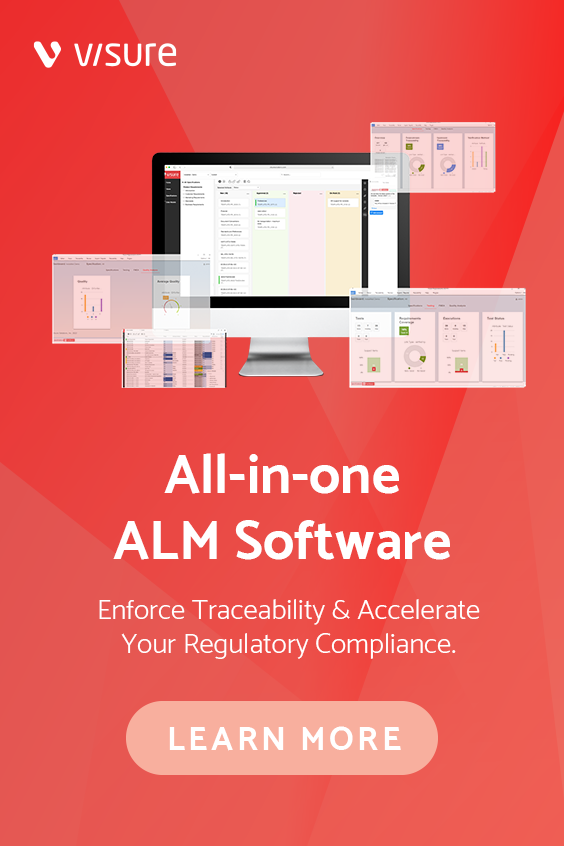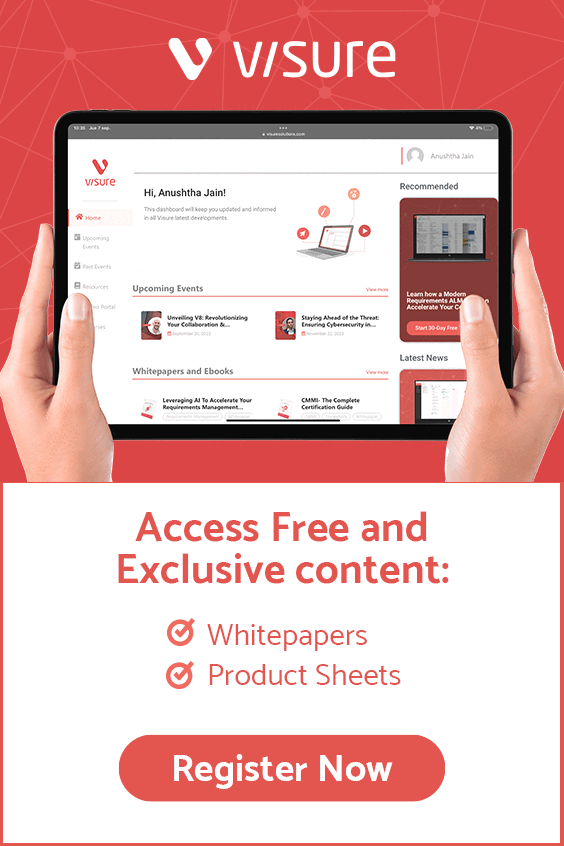What is Visure Solutions?
Visure Solutions is an all-in-one comprehensive solution that covers various application lifecycle management practices such as requirements management, test management, risk management, defect tracking, quality analysis, industrial standard compliance, and document and report generation. Visure offers end-to-end traceability with project objectives, resource allocation, risk and test management, compliance with various industry-specific standards, quality assurance processes, and cost optimization capabilities. It supports multi-site distributed environments as well as cloud deployments. Additionally, it offers full scalability from small teams working together to large enterprise initiatives. The platform also integrates easily with MS Word/Excel and other legacy tools like IBM DOORS, Jira, MatLab Simulink, GitLab, MicroFocus ALM, ReqIF, VectorCast, Enterprise Architect, and many more.
Visure Solutions also offers a range of industry-specific solutions for sectors such as automotive, aerospace and defense, telecoms and electronics, medical technology, energy and utilities, and finance. These sector-specific solutions are tailored to meet the specific needs of each industry and offer the capabilities needed to ensure the best results. By employing Visure Solutions in these industries, companies can increase their competitive advantage by ensuring that all projects meet customer expectations as well as regulatory requirements. Additionally, with its integrated tracking systems and comprehensive portfolio of tools and services, it is easy to track progress from concept to completion quickly and accurately. This helps accelerate time-to-market while still maintaining high-quality standards throughout the product/service development process.
What is IBM DOORS?
IBM DOORS (Dynamic Object Oriented Requirements System) is a requirements management software tool developed by IBM and used mainly in the aerospace, automotive, and defense industries. It helps project teams capture, trace, analyze, and manage changes to requirements throughout the development lifecycle of a product or system. The central repository of IBM DOORS stores information on requirements, their relationships with other requirements, and external documents such as images and source code. With its visual interface, team members can quickly create complex linkages between related pieces of data such as requirements and design documents that would otherwise be difficult to manage using traditional methods. Additionally, it provides features like impact analysis which allows project teams to identify how any given change may affect the entire system so that risks can be managed more efficiently. IBM DOORS is a popular tool for managing and tracking requirements as it offers great flexibility, scalability, and customization options. It also allows project teams to integrate with other tools such as IBM Rational System Architect (SA) or Microsoft Excel. Ultimately, the goal of using this software is to help create a clear picture of the project’s objectives, goals, and deliverables—and to ensure that all stakeholders are on the same page when making decisions about the development of products or systems.
Integration From DOORS To Visure
Visure Requirements offers integration with IBM DOORS to create a seamless and powerful requirements management ecosystem. This makes it easier for project teams to track, manage, verify, and analyze their requirements in one place. The integration allows users to quickly import modules from IBM DOORS into Visure Requirements using the drag-and-drop feature, thus eliminating the need for tedious manual data entry or conversion processes.

Additionally, users can easily link requirements together within Visure Requirements or update existing links from IBM DOORS as needed; making sure that any changes are tracked and recorded accurately. Finally, all documents associated with requirements created in either tool can be imported into Visure Requirements enabling team members to quickly review related information such as specification documents or source code when necessary.
The Migration Path:
The XRI (XML For Requirements Interchange) Format –
The XRI (XML for Requirements Interchange) format is a standard developed by the Object Management Group to exchange requirements between different tools. It provides an open, platform-independent, XML-based language that can be used to represent both structured and unstructured information in a requirements document. This makes it ideal for integration with other tools such as IBM DOORS so that teams can share their requirements data without having to manually convert them into a specific format or structure. With XRI, project teams can easily import modules from IBM DOORS into Visure Requirements with just a few clicks of the mouse; thus ensuring that information remains consistent and accessible across platforms and enabling better collaboration among stakeholders.
7 Things To Consider When Migrating From DOORS To Visure
The 7 major things to consider when one migrates from IBM DOORS to Visure include:
- Defining the Correct Project Structure:
- Project Structure (DOORS Modules ➡️ Visure Specifications)
- Modules (DOORS Objects ➡️ Visure Items)
- Traceability (DOORS Link types ➡️ Visure Data Models)
- Mapping Unique Identifiers
- Tables, tables, tables… tables!
- Migrating OLE Objects
- DXL (DOORS eXtended Language)
- Mapping User Attributes and Workflows
- Project Migration Strategies
Why On Should Migrate From DOORS To Visure?
- All-in-One Platform – Visure Requirements is an all-in-one platform for requirements engineering teams to gather, analyze, store, and manage requirements. The key benefits of using Visure Requirements include strong test management, risk management, bug and defect tracking, high-end quality analysis, industrial standard compliance, and customizable document generation.
- Multi-Environment Deployment – Visure can be operated both via the browser and via the application. This allows teams to access and manage their requirements from any location, making it more convenient and cost-effective.
- MS Office Round-Trip Integration – Visure further provides robust to-and-fro integration with Microsoft Word and Excel. This helps teams seamlessly import and export their requirements into different documents and spreadsheet formats.
- Collaboration – Visure Requirements offers enhanced collaboration capabilities, allowing teams to easily access and share their requirements from any location. This makes it easier for team members to keep up-to-date with the progress of their projects without having to search through multiple sources or tools.
- Modern Views – Visure provides various modern views also like the Kanban view. This helps users to visualize all the requirements on a single page in modern styles.
- Modern Impact Analysis – Visure offers a powerful impact analysis capability that helps teams identify the potential effect of changes on other parts/requirements of their projects. This makes it easier for them to make informed decisions and take corrective action quickly.
- Workflows – Visure also provides users with customizable workflows that can be tailored to match their specific needs. This helps teams streamline their processes and eliminate redundant tasks for greater efficiency.
- Reusability – Visure Requirements also allow teams to save time and resources by reusing existing requirements for future projects. This helps them avoid having to start from scratch each time, resulting in greater efficiency.
- Industry-specific Capabilities – Visure Requirements provides industry-specific capabilities to various safety-critical industries, such as Aerospace and Defense, Medical Devices, Automotive, Oil and Gas, and many more, that help teams meet the requirements of their specific industries. This ensures compliance with industry standards and helps them deliver projects faster.
Conclusion:
Visure Requirements provides the necessary tools and capabilities needed to help teams develop high-quality products, achieve compliance with industry standards, and automate their workflows. With its powerful features, Visure helps teams streamline their processes, collaborate more effectively, automate tedious tasks, and ensure security across all data stored in their system. With these features in place, teams can improve productivity while delivering projects faster and more efficiently.
Overall, IBM DOORS is a great tool for requirements engineering but when it is combined with Visure Requirements organizations can take advantage of enhanced traceability, scalability, collaboration and security capabilities that help them deliver projects faster than ever before. The solution also offers customizable views so teams can easily monitor progress on projects as well as reusability and industry-specific capabilities that help them stay compliant with regulations. This allows them to develop products of the highest quality while reducing costs and saving time. With Visure Requirements in their toolkit, teams can be sure to get the job done quickly and efficiently.
Get a free 14-day trial now to know more about Visure Requirements ALM Platform.


